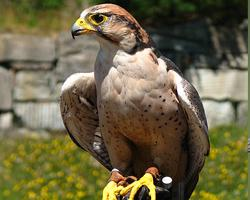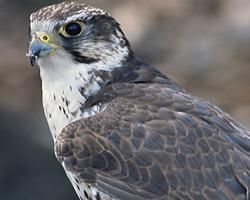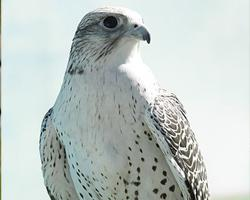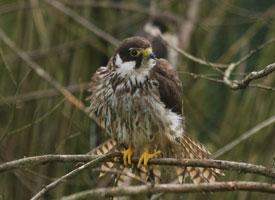
Váhy a míry
| Délka | od 43 do 50 cm |
|---|---|
| Délka rozpětí křídel | od 95 do 105 cm |
Stav ohrožení
| Ohrožen |
Popis zvířete
The Lanner Falcon (Falco biarmicus) is a medium-sized bird of prey that is part of the larger falcon family. This raptor stands out due to its powerful build, swift flight, and striking appearance. Adult Lanner Falcons typically measure between 43 to 50 centimeters (17 to 20 inches) in length, with a wingspan ranging from 95 to 105 centimeters (37 to 41 inches). Males are generally smaller than females, a common sexual dimorphism observed in birds of prey.The plumage of the Lanner Falcon is predominantly gray and brown, with a distinctive bluish-gray cap and nape that contrasts sharply with its rufous neck. The upper parts of the bird are slate gray, while the underparts are a paler shade, often streaked with brown. Juveniles are generally darker and more heavily streaked than adults. One of the most striking features of this bird is its intense, reddish-brown eyes, set in a face adorned with a black malar stripe that contrasts with its pale cheeks.
Lanner Falcons are highly adapted predators. They have strong, sharp talons and a powerful beak that is notched to help kill and dismember their prey. Their exceptional vision allows them to spot potential meals from great distances. In flight, they exhibit remarkable agility and speed, capable of sudden bursts of acceleration during a chase or while diving to catch prey in mid-air. Their diet is varied, consisting primarily of birds, ranging from small songbirds to larger species such as doves and pigeons. They also occasionally hunt small mammals, reptiles, and insects.
These falcons are found across a broad range, primarily inhabiting parts of Africa, the Middle East, and the Mediterranean. Their preferred habitats include a variety of open and semi-open landscapes, such as arid savannahs, mountainous regions, and cultivated fields, often in close proximity to cliffs or other high vantage points used for nesting and hunting.
Lanner Falcons are monogamous and territorial during the breeding season. They typically nest on cliffs, in crevices or on ledges, where the female lays a clutch of 3 to 4 eggs. Both parents share responsibilities in incubating the eggs and feeding the young. The chicks are altricial, meaning they are born relatively helpless and require significant parental care before fledging.
While not currently listed as endangered, Lanner Falcon populations are facing pressures from habitat loss, pesticide use, and direct persecution. In some parts of their range, they are also captured for falconry, a practice that has both historical and contemporary significance. Conservation efforts aimed at preserving their habitats and regulating falconry practices are vital for ensuring the survival of these majestic birds.
In summary, the Lanner Falcon is a remarkable bird of prey, known for its beauty, agility, and prowess as a hunter. Its presence across diverse landscapes highlights its adaptability, yet underscores the importance of concerted conservation efforts to safeguard its future.
Podobná zvířata
Nové fotografie zvířat
Top 10 zvířat
- Chinese water dragon (Physignathus cocincinus)
- Galápagos tortoise (Geochelone nigra complex)
- Dolphin gull (Leucophaeus scoresbii)
- Japanese macaque (Macaca fuscata)
- Colombian red howler (Alouatta seniculus)
- Sea urchins (Echinoidea)
- Moustached guenon (Cercopithecus cephus)
- Diana monkey (Cercopithecus diana)
- Common reed warbler (Acrocephalus scirpaceus)
- Common house mosquito (Culex pipiens)


